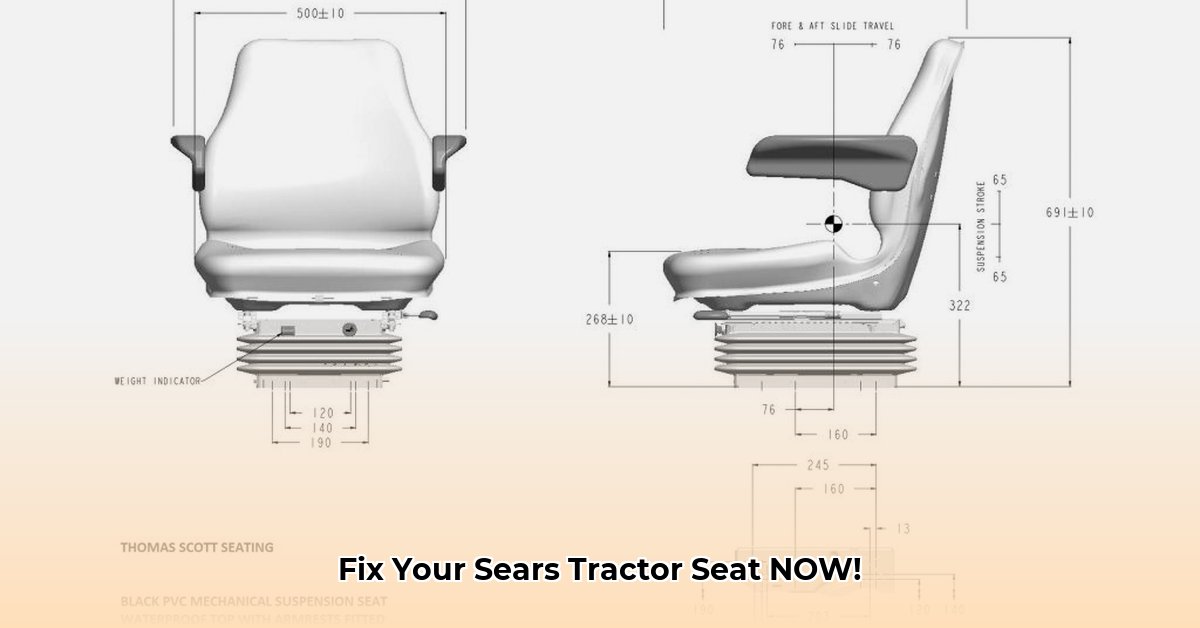
Sears Tractor Seat Parts: Prioritizing Comfort and Productivity
Long hours on a tractor can take a toll. A comfortable seat isn't a luxury; it's essential for a productive and healthy workday. This guide focuses on finding the right Sears tractor seat parts to maximize your comfort and farm efficiency. We'll cover choosing the right parts, troubleshooting issues, performing maintenance, and even upgrading for enhanced performance. For more options, check out these other tractor seats.
Understanding Your Tractor Seat Needs: Beyond Basic Seating
Before searching for parts, consider your daily routine. How many hours do you typically spend on your tractor? What terrain do you cover? Do you work mostly on smooth surfaces or traverse rough fields? These factors influence your seat requirements.
A high-quality tractor seat minimizes fatigue. It provides proper back support, reducing the risk of aches and pains. It also absorbs shocks and vibrations (reducing fatigue). Remember, this is an investment in your well-being – crucial for long-term success. Neglecting repairs can lead to discomfort, injury, and costly downtime.
Finding the Right Sears Tractor Seat Parts: Your Options
Several avenues exist for sourcing Sears tractor seat parts:
Online Tractor Part Retailers: These offer vast inventories and detailed diagrams. Careful part number selection is crucial to avoid costly mistakes.
Local Agricultural Equipment Dealers: Local dealers offer personalized service and expert advice, though they might be pricier than online options.
Sears Directly (if applicable): Check Sears' website or contact customer support, particularly for newer tractors or less common parts. Availability might be limited for older models.
Always have your tractor's model and serial number ready to ensure accurate part selection. Installing the wrong part can create further problems.
Decoding Your Tractor Seat: Key Components
Many online retailers provide diagrams showing individual seat components. Common parts include:
| Part Name | Description | Typical Replacement Frequency |
|---|---|---|
| Seat Cushion | The main seating surface. | Varies, depending on wear and tear |
| Seat Back | Provides lumbar support. | Varies, depending on wear and tear |
| Suspension Components | Springs, shock absorbers—dampen vibrations. | Every 2-5 years, depending on usage |
| Armrests | Provide arm support and comfort. | As needed |
| Upholstery/Cover | The fabric covering the seat. | As needed; can be cosmetic or structural |
Maintaining Your Seat: A Simple Preventative Plan
Regular seat maintenance extends its lifespan and saves money on repairs. Follow this simple routine:
Regular Cleaning: Regularly wipe away dirt and debris; use appropriate cleaning solutions.
Thorough Inspections: Periodically check for wear and tear, focusing on suspension, seams, and upholstery.
Fastener Tightening: Ensure all bolts and fasteners are securely tightened to prevent loose parts and safety hazards.
Lubrication (if applicable): Lubricate moving parts in the suspension system to maintain smooth operation.
The Benefits of Proactive Seat Maintenance
Investing in your tractor seat's upkeep offers significant returns. A comfortable seat equates to a more productive workday, reduced fatigue, and fewer aches and pains. This translates to better health, higher output, and a more successful farming operation. Proactive maintenance prevents costly repairs down the line.
How to Reduce Tractor Operator Fatigue with Ergonomic Seating
Modern farming demands long hours. Backaches, neck stiffness, and exhaustion are common. Ergonomic seating can dramatically improve your workday.
Ergonomic Tractor Seats: Investing in Your Well-being
Your tractor seat is your command center. A poorly designed seat is inefficient and uncomfortable. An ergonomic seat provides proper support, minimizing strain and cushioning vibrations. Adjustability is key, allowing you to find the perfect position. Replacing worn parts maintains optimal seat performance.
Evaluating Your Current Seat
Before buying new parts, assess your existing seat:
- Cushioning: Is it firm yet comfortable, offering adequate support?
- Suspension: Does it effectively absorb shocks and vibrations?
- Adjustability: Can you easily adjust height, backrest angle, and lumbar support?
- Durability: Is it showing signs of wear?
If your seat falls short in any area, an upgrade is warranted.
Finding the Right Sears Tractor Seat Parts: A Step-by-Step Guide
Identify Your Tractor Model: Find your tractor's model number (usually on a sticker).
Locate Parts Diagram: Use online resources or Sears' documentation to find a diagram for your model.
Check Part Numbers: Note the numbers for parts needing replacement or upgrade.
Source the Parts: Order the parts from Sears or a reputable supplier.
Installation: Follow instructions carefully, seeking professional help if needed.
Long-Term Benefits of Ergonomic Seating
Investing in ergonomic seating yields multiple benefits:
- Increased Productivity: Reduced fatigue leads to more efficient work.
- Reduced Injury Risk: Proper support minimizes the risk of back problems.
- Improved Safety: A comfortable operator is a more alert operator.
- Better Health: Reduced aches and pains contribute to better overall well-being.
Investing in the right Sears tractor seat parts is an investment in your health, productivity, and the long-term success of your farming operation. It's about creating a safer and more comfortable work environment.